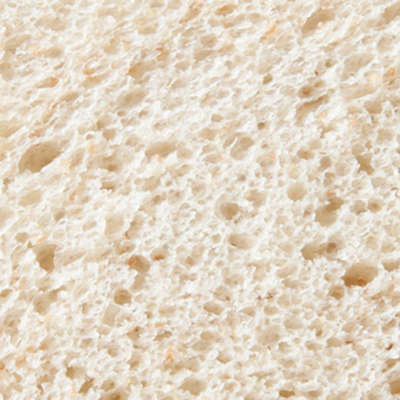
Baking Quality
What is baking quality?
Baking quality is a concept used by bakers to determine the potential of cereal flours (wholemeal and/or refined) in the manufacture of yeast-leavened breads and buns or chemically-leavened sweet goods such as cakes, waffles, muffins or cookies.1
- Baking quality is intimately related to the quantity and quality of gluten-forming proteins
- These proteins create the unique gluten film
- This supports the structure of yeasted doughs and modifies the rheology of batters
How does it work?
Baking quality is a broad concept that involves:
- Baking tests such as gassing power, gas retention, mixing tolerance/stability, and water absorption
- Assessment of loaf volume, texture and crumb grain structure of finished products
- Small production runs to adjust formulation and processing
- Sensory evaluation of baked goods
Depending on the finished product and processing conditions, wheat flours need to comply with specifications of:1,2
- Composition: protein, ash, moisture, bran particles, non-starch/cell wall polysaccharides or damaged starch
- Post-harvest enzymatic activity
- Post-milling treatment: malting or enzyme supplementation, enrichment, bleaching, maturing
- Particle size
- Interaction with ingredients such as water
- Rheological behavior: starch pasting, shear thinning properties, batter viscosity
- Processing: mixing and leavening performance
Application
Baking quality in yeast-leavened products
Flours used in artisan, white pan bread, buns and some pastry goods need higher protein content. This provides extensibility, machinability and high yield.
During fermentation, the dough structure should be strong enough to hold the carbon dioxide produced by the yeast. It’s also essential to get optimum bread volume. Here, both gas production by yeast from fermentable sugars and gas retention of dough play a critical role.3,4
Deficiencies in flour quality can be compensated for by adding vital wheat gluten. Or, by using dough conditioning ingredients and modifying existing production procedures.
Baking quality in chemically-leavened products
Given the low flour level compared to other ingredients in formula (e.g. water, fats, sugars), soft wheat products from aerated oil-in-water emulsions (i.e. batters), do not require yeast and gas retention capabilities, and any enzymatic activity could be considered detrimental to quality.
High-quality cakes rely on proper ingredient adjustment and knowledge of the chemistry and function of sugars, fats, eggs, gums, starches and baking powders.
Typical tests used in assessing baking quality of flours:1
| Test | Properties evaluated | Deliverables |
| Mixograph (Recording dough mixer) | Rheological (viscoelasticity) | Tolerance index, stability, water absorption, development time. |
| Farinograph (Recording dough mixer) | Rheological (viscoelasticity) | Development time, water absorption, stability. |
| Extensograph | Mechanical | Maximum resistance to extension of a fully mixed dough, extensibility, work (total deformation energy or flour strength). |
| Alveograph | Mechanical | Maximum pressure (resistance to deformation), extensibility, elasticity index, work (total expansion energy or flour strength). |
| Mixolab | Rheological | Determines dough-mixing characteristics and gluten strength, pasting, viscosity, and retrogradation. |
| Particle size distribution (Sieving) | Physical | Percent of flour particles that pass through sieves of certain mesh size. Key parameter for hydration and dough/batter qualities. |
| Gluten washing | Compositional | Dry gluten, wet gluten, gluten strength, indirect measure of batter spread. |
| Protein, damaged starch, arabinoxylans, ash, moisture content | Compositional | Components important for flour hydration and overall baked product. |
| Sedimentation | Relative gluten strength (water absorption) | Height of sedimented flour–water slurry in milliliters in a graduated tube related to protein quantity and quality, indirect measure of batter spread. |
| Solvent Retention Capacity | Water absorption and polymer properties | Percent of weight gained in hydrated gel, indirect measure of batter spread. |
| Fermentograph | Yeast activity (optimum yeast level) | CO2 gas production during dough fermentation as function of yeast vitality and fermentable sugars (pre-existing in flour, those broken down from starch and added in formula). |
| Falling Number | Rheological, enzymatic activity (α-amylase) | Key for determining malted barley level and adjusting sugar in bread formulas. |
| Viscoamylograph | Rheological, enzymatic activity | Measures viscosity of a stirred flour-water slurry during a programmed temperature increase. |
| Rapid Visco Analyzer | Rheological, enzymatic activity | Measures viscosity of a stirred flour-water slurry during a programmed temperature increase. |
| Crumb Analysis | Imaging | Cell uniformity, number of cells, quantification of holes, cell size, cell wall thickness, cell diameter. |
References
- Finnie, S., and Atwell, W.A. Wheat Flour Handbook Series, 2nd edition, AACC International, Inc., 2016.
- Carson, G.R., and Edwards, N.M. “Criteria of Wheat and Flour quality.” Wheat Chemistry and Technology, 4th edition, AACC International, Inc., 2017, pp. 97–118.
- Delcour, J.A., and Hoseney, R.C. Principles of Cereal Science and Technology, 3rd edition, AACC International, Inc., 2010.
- Gélinas P, McKinnon C. Baking tests: Effect of sucrose and water on yeast gassing power. Cereal Chem. 2018;95:822–828.

